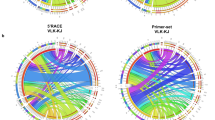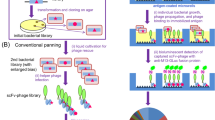Abstract
We have developed a strategy for guiding the selection of human antibody fragments from phage display repertoires to a single epitope of an antigen, using rodent monoclonal antibodies as a template. Thus the heavy chain of a rodent antibody (MAb32) directed against human tumor necrosis factor α (TNFα) was cloned and paired as a template chain with a repertoire of human light chains for display as Fab fragments on filamentous phage. The phage were selected by binding to the antigen. The selected human light chains were in turn paired with a repertoire of human heavy chains displayed on phage, and the phage selected again. The isolated phage displaying human antibody fragments binding to TNFα also bound to a peptide comprising the N–terminal region of TNFα as with MAb32. One of the human Fab fragments was recloned for expression as a glycosylated human antibody in mammalian cells: Binding to TNFα could be competed with MAb32 or with anti–serum to the peptide, indicating the same epitope. The human antibody was found to have a binding affinity (Kd=15 nM) similar to MAb32 (Kd=26 nM). The process contrasts with existing means of “humanizing” rodent monoclonal antibodies in that the antibodies derived are completely human.
This is a preview of subscription content, access via your institution
Access options
Subscribe to this journal
Receive 12 print issues and online access
$209.00 per year
only $17.42 per issue
Buy this article
- Purchase on Springer Link
- Instant access to full article PDF
Prices may be subject to local taxes which are calculated during checkout
Similar content being viewed by others
References
McCafferty, J., Griffiths, A.D., Winter, G. and Chiswell, D.J. 1990. Phage antibodies: filamentous phage displaying antibody variable domains. Nature 348: 552–554.
Winter, G., Griffiths, A.D., Hawkins, R.E. and Hoogenboom, H.R. 1994. Making antibodies by phage display technology. Ann. Rev. Immunol. 12: 433–455.
Clackson, T., Hoogenboom, H.R., Griffiths, A.D. and Winter, G. 1991. Making antibody fragments using phage display libraries. Nature 352: 624–628.
Griffiths, A.D., et al. 1994. Isolation of high affinity human antibodies directly from large synthetic repertoires. EMBO J. In press.
Marks, J.D., Griffiths, A.D., Malmqvist, M., Clackson, T.P., Bye, J.M. and Winter, G. 1992. By-passing immunization: Building high affinity human antibodies by chain shuffling. Bio/Technology 10: 779–783.
Barbas, C.F., Languino, L.R. and Smith, J.W. 1993. High-affinity self-reactive human antibodies by design and selection: targeting the integrin ligand binding site. Proc. Natl. Acad. Sci. USA 90: 10003–10007.
Marks, J.D., Hoogenboom, H.R., Bonnert, T.P., McCafferty, J., Griffiths, A.D. and Winter, G. 1991. By-passing immunization: Human antibodies from V-gene libraries displayed on phage. J. Mol. Biol. 222: 581–597.
Hoogenboom, H.R. and Winter, G. 1992. By-passing immunisation. Human antibodies from synthetic repertoires of germline VH-gene segments rearranged in vitro. J. Mol. Biol 227: 381–388.
Griffiths, A.D., Malmqvist, M., Marks, J.D., Bye, J.M., Embleton, M.J., McCafferty, J., Baier, M., Holliger, K.P., Gorick, B.D., Hughes, J.N., Hoogenboom, H.R. and Winter, G. 1993. Human anti-self antibodies with high specificity from phage display libraries. EMBO J. 12: 725–734.
Burton, D.R., Barbas, C.F., Persson, M.A.A., Koenig, S., Chanock, R.M. and Lerner, R.A. 1991. A large array of human monoclonal antibodies to type 1 human immunodeficiency virus from combinatorial libraries of asymptomatic individuals. Proc. Natl. Acad. Sci. USA 88: 10134–10137.
Zebedee, S.L., Barbas, C.F., Hom, Y., Caothien, R.H., Graff, R., Degraw, J., Pyati, J., LaPolla, R., Burton, D.R., Lerner, R.A. and Thornton, G.B. 1992. Human combinatorial antibody libraries to hepatitis B surface antigen. Proc. Natl. Acad. Sci. USA 89: 3175–3179.
Marks, J.D., Ouwehand, W.H., Bye, J.M., Finnern, R., Gorick, B.D., Voak, D., Thorpe, S.J., Hughes-Jones, N.C. and Winter, G. 1993. Human antibody fragments specific for human blood group antigens from a phage display library. Bio/Technology 11: 1145–1149.
Nissim, A., Hoogenboom, H.R., Tomlinson, I.M., Flynn, G., Midgley, C., Lane, D. and Winter, G. 1994. Antibody fragments from a ‘single pot’ phage display library as immunochemical reagents. EMBO J. 13: 692–698.
Figini, M., Marks, J.D., Winter, G. and Griffiths, A.D. 1994. In vitro assembly of repertoires of antibody chains by renaturation on the surface of phage. J. Mol. Biol. 239: 68–78.
Hoogenboom, H.R., Griffiths, A.D., Johnson, K.S., Chiswell, D.J., Hudson, P. and Winter, G. 1991. Multi-subunit proteins on the surface of filamentous phage: methodologies for displaying antibody (Fab) heavy and light chains. Nucl. Acids Res. 19: 4133–4137.
Williams, S.C. and Winter, G. 1993. Cloning and sequencing of human immunoglobulin V lambda gene segments. Eur. J. Immunol. 23: 1456–1461.
Tomlinson, I.M., Walter, G., Marks, J.D., Llewelyn, M.B. and Winter, G. 1992. The repertoire of human germline VH sequences reveals about fifty groups of VH segments with different hypervariable loops. J. Mol. Biol. 227: 776–798.
Rathjen, D.A. and Aston, R. 1993. Selective enhancement of tumour necrosis factor activity: mapping regions with monoclonal antibodies. Biomed. Chem. Lett. 3: 457–462.
Rathjen, D.A., Cowan, K., Furphy, L.J. and Aston, R. 1991. Antigenic structure of human tumour necrosis factor: recognition of distinct regions of TNF alpha by different tumour cell receptors. Mol. Immunol. 28: 79–86.
Friguet, B., Chaffotte, A.F., Djavadi, O.L. and Goldberg, M.E. 1985. Measurements of the true affinity constant in solution of antigen-antibody complexes by enzyme-linked immunosorbent assay. J. Immunol. Methods 77: 305–319.
Goldberg, M.E. and Djavadi, O.L. 1993. Methods for measurement of antibody/antigen affinity based on ELISA and RIA. Curr. Opin. Immunol. 5: 278–81.
Cox, J.P.L., Tomlinson, I.M. and Winter, G. 1994. A directory of human germ-line Vκ segments reveals a strong bias in their usage. Eur. J. Immunol. 24: 827–836.
Waterhouse, P., Griffiths, A.D., Johnson, K.S. and Winter, G. 1993. Combinatorial infection and in vivo recombination: a strategy for making large phage antibody repertoires. Nucl. Acids Res. 21: 2265–2266.
Huse, W.D., Sastry, L., Iverson, S.A., Kang, A.S., Alting, M.M., Burton, D.R., Benkovic, S.J. and Lerner, R.A. 1989. Generation of a large combinatorial library of the immunoglobulin repertoire in phage lambda. Science 246: 1275–1281.
Winter, G. and Harris, W.J. 1993. Humanized antibodies. Trends Pharmacol. Sci. 14: 139–143.
Jones, P.T., Dear, P.H., Foote, J., Neuberger, M.S. and Winter, G. 1986. Replacing the complementarity-determining regions in a human antibody with those from a mouse. Nature 321: 522–525.
Kabat, E.A., Wu, T.T., Perry, H.M., Gottesman, K.S. and Foeller, C. 1991. Sequences of Proteins of Immunological Interest. 5th Edit. U.S. Department of Health and Human Services, Public Health Service National Institutes of Health.
Orlandi, R., Gussow, D.H., Jones, P.T. and Winter, G. 1989. Cloning immunoglobulin variable domains for expression by the polymerase chain reaction. Proc. Natl. Acad. Sci. USA 86: 3833–3837.
Foote, J. and Winter, G. 1992. Antibody framework residues affecting the conformation of the hypervariable loops. J. Mol. Biol. 224: 487–499.
Sanger, F., Nicklen, S. and Coulson, A.R. 1977. DNA sequencing with chain-terminating inhibitors. Proc. Natl. Acad. Sci. USA 74: 5463–5467.
Author information
Authors and Affiliations
Rights and permissions
About this article
Cite this article
Jespers, L., Roberts, A., Mahler, S. et al. Guiding the Selection of Human Antibodies from Phage Display Repertoires to a Single Epitope of an Antigen. Nat Biotechnol 12, 899–903 (1994). https://doi.org/10.1038/nbt0994-899
Received:
Accepted:
Issue Date:
DOI: https://doi.org/10.1038/nbt0994-899
This article is cited by
-
Streamlined human antibody generation and optimization by exploiting designed immunoglobulin loci in a B cell line
Cellular & Molecular Immunology (2021)
-
Detection of adalimumab and anti-adalimumab antibodies in patients with rheumatoid arthritis: a comprehensive overview of methodology pitfalls and benefits
Immunologic Research (2017)



